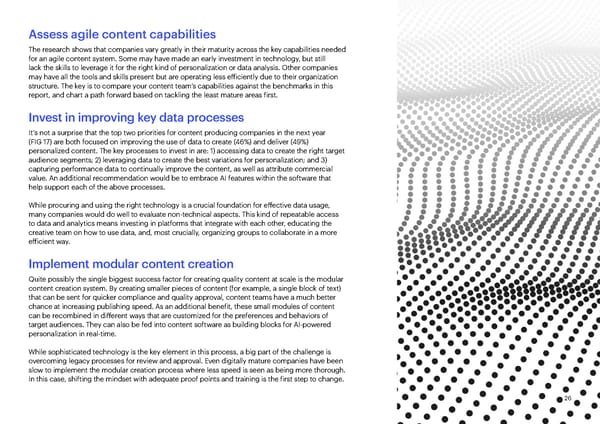Assess agile content capabilities The research shows that companies vary greatly in their maturity across the key capabilities needed for an agile content system. Some may have made an early investment in technology, but still lack the skills to leverage it for the right kind of personalization or data analysis. Other companies may have all the tools and skills present but are operating less efficiently due to their organization structure. The key is to compare your content team’s capabilities against the benchmarks in this report, and chart a path forward based on tackling the least mature areas first. Invest in improving key data processes It’s not a surprise that the top two priorities for content producing companies in the next year (FIG 17) are both focused on improving the use of data to create (46%) and deliver (49%) personalized content. The key processes to invest in are: 1) accessing data to create the right target audience segments; 2) leveraging data to create the best variations for personalization; and 3) capturing performance data to continually improve the content, as well as attribute commercial value. An additional recommendation would be to embrace AI features within the software that help support each of the above processes. While procuring and using the right technology is a crucial foundation for effective data usage, many companies would do well to evaluate non-technical aspects. This kind of repeatable access to data and analytics means investing in platforms that integrate with each other, educating the creative team on how to use data, and, most crucially, organizing groups to collaborate in a more efficient way. Implement modular content creation Quite possibly the single biggest success factor for creating quality content at scale is the modular content creation system. By creating smaller pieces of content (for example, a single block of text) that can be sent for quicker compliance and quality approval, content teams have a much better chance at increasing publishing speed. As an additional benefit, these small modules of content can be recombined in different ways that are customized for the preferences and behaviors of target audiences. They can also be fed into content software as building blocks for AI-powered personalization in real-time. While sophisticated technology is the key element in this process, a big part of the challenge is overcoming legacy processes for review and approval. Even digitally mature companies have been slow to implement the modular creation process where less speed is seen as being more thorough. In this case, shifting the mindset with adequate proof points and training is the first step to change. 26
 State of Digital Content Page 25 Page 27
State of Digital Content Page 25 Page 27